临床研究设计类型
临床试验设计的五种类型
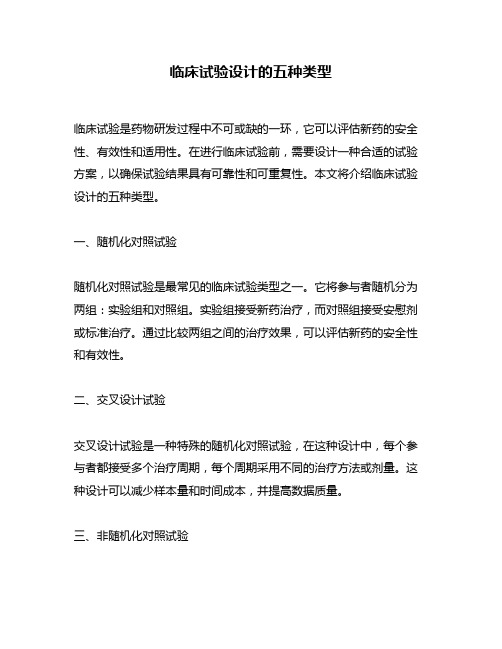
临床试验设计的五种类型临床试验是药物研发过程中不可或缺的一环,它可以评估新药的安全性、有效性和适用性。
在进行临床试验前,需要设计一种合适的试验方案,以确保试验结果具有可靠性和可重复性。
本文将介绍临床试验设计的五种类型。
一、随机化对照试验随机化对照试验是最常见的临床试验类型之一。
它将参与者随机分为两组:实验组和对照组。
实验组接受新药治疗,而对照组接受安慰剂或标准治疗。
通过比较两组之间的治疗效果,可以评估新药的安全性和有效性。
二、交叉设计试验交叉设计试验是一种特殊的随机化对照试验,在这种设计中,每个参与者都接受多个治疗周期,每个周期采用不同的治疗方法或剂量。
这种设计可以减少样本量和时间成本,并提高数据质量。
三、非随机化对照试验非随机化对照试验是一种没有随机分配参与者到实验组和对照组的临床试验类型。
在这种设计中,参与者自愿选择接受治疗或不接受治疗。
虽然这种设计可以提供一些有用的信息,但是由于样本选择偏差和其他因素的影响,结果可能不够可靠。
四、单臂试验单臂试验是一种只有一个实验组的临床试验类型。
在这种设计中,所有参与者都接受新药治疗,并且没有对照组。
这种设计适用于罕见疾病或无法招募足够多的对照组参与者的情况下。
五、队列研究队列研究是一种观察性研究类型,它跟踪一群人随着时间的推移而发生某种事件(例如患某种疾病或死亡)的情况。
在这种设计中,参与者没有被随机分配到实验组和对照组。
这种设计适用于探索性和描述性目的。
总结以上是临床试验设计的五种类型:随机化对照试验、交叉设计试验、非随机化对照试验、单臂试验和队列研究。
每个类型都有其优缺点和适用场景,根据具体情况选择适合的试验设计是保证试验结果可靠性和有效性的关键。
临床医学常见科研设计方案
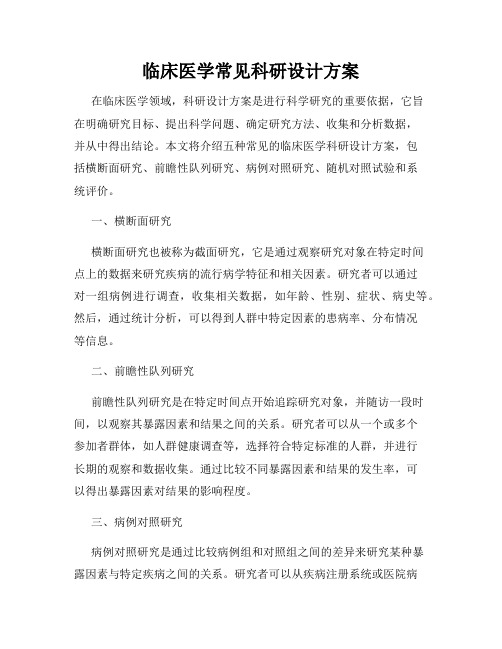
临床医学常见科研设计方案在临床医学领域,科研设计方案是进行科学研究的重要依据,它旨在明确研究目标、提出科学问题、确定研究方法、收集和分析数据,并从中得出结论。
本文将介绍五种常见的临床医学科研设计方案,包括横断面研究、前瞻性队列研究、病例对照研究、随机对照试验和系统评价。
一、横断面研究横断面研究也被称为截面研究,它是通过观察研究对象在特定时间点上的数据来研究疾病的流行病学特征和相关因素。
研究者可以通过对一组病例进行调查,收集相关数据,如年龄、性别、症状、病史等。
然后,通过统计分析,可以得到人群中特定因素的患病率、分布情况等信息。
二、前瞻性队列研究前瞻性队列研究是在特定时间点开始追踪研究对象,并随访一段时间,以观察其暴露因素和结果之间的关系。
研究者可以从一个或多个参加者群体,如人群健康调查等,选择符合特定标准的人群,并进行长期的观察和数据收集。
通过比较不同暴露因素和结果的发生率,可以得出暴露因素对结果的影响程度。
三、病例对照研究病例对照研究是通过比较病例组和对照组之间的差异来研究某种暴露因素与特定疾病之间的关系。
研究者可以从疾病注册系统或医院病案系统中选取一组已确诊的病例,并选择与病例组相近的人群作为对照组。
然后,通过回顾性地比较两组的暴露状况,分析暴露因素和疾病之间的关联性。
四、随机对照试验随机对照试验是一种通过随机分组、干预和对照来评估某种干预措施对结果的影响的研究设计。
研究者可以从一群符合特定标准的人群中随机选择一部分人作为干预组,给予特定干预措施,而将另一部分人作为对照组,不给予干预。
通过对两组进行比较,可以评估干预对结果的影响。
五、系统评价系统评价是通过系统地搜集、评价和分析多个独立研究的结果,以回答特定的研究问题。
系统评价可以包括横断面研究、前瞻性队列研究、病例对照研究和随机对照试验等不同类型的研究。
研究者可以通过系统性的文献搜索和筛选,提取相关研究的数据,并进行合并分析,以得出更具统计学意义和临床应用价值的结论。
临床研究设计

临床研究设计随着医学科技的不断发展,临床研究在医学领域中的重要性逐渐增强。
临床研究设计是指在医学实践中,为了回答特定的研究问题或验证某种假设而采取的科学性研究方法。
一个合理的研究设计是确保研究结果的准确性和可靠性的基础。
本文将介绍几种常见的临床研究设计以及它们的特点和应用。
一、随机对照试验设计随机对照试验是临床研究中最常见也是最可靠的设计方法之一。
它通过将研究对象随机分组,分别对照组和实验组进行不同的处理或干预措施,然后比较两组之间的差异,推断干预因素的疗效。
在随机对照试验中,尽可能保持受试者之间的类似性,以减少其他因素对干预效果的干扰。
随机对照试验的优点在于能够最大程度地控制干预因素的干扰,并能够通过比较两组的结果得出干预措施的疗效。
但是在一些具体情况下,随机对照试验可能不太容易实施,例如对于涉及到伦理问题的研究,或样本数量有限的研究。
二、队列研究设计队列研究是一种观察性研究设计,通过对一组具有相似特征的人群进行长期的跟踪观察,以寻找暴露和结果之间的关联。
队列研究一般分为前瞻性队列研究和回顾性队列研究。
前瞻性队列研究是通过在起始点时收集研究对象的相关信息,然后对其进行跟踪观察,记录暴露因素与结果的关系。
前瞻性队列研究能够提供高质量的证据,但需要长时间的跟踪观察,成本较高。
回顾性队列研究则是利用已有的数据,对历史上曾进行过某种暴露的人群进行观察研究,探寻暴露因素与结果之间的关系。
回顾性队列研究是一种经济高效的研究方法,但由于数据的来源不一定实时和全面,结果可能受到偏倚影响。
三、趋势研究设计趋势研究设计用于研究特定现象随时间的变化规律。
它通过多次观察同一群体的特征或现象,分析其变化趋势来推断其原因和发展方向。
趋势研究采集数据的频率较高,能够全面了解研究对象的演变过程。
趋势研究的主要优势在于能够观察到长期变化的趋势,推断出潜在的规律和因果关系。
然而,由于趋势研究无法控制其他潜在变量的干扰,因此其结论可能受到其他因素的影响。
临床分析研究常见的设计类型

临床分析研究常见的设计类型在医学领域中,临床分析研究是一种对疾病的预防、诊断、治疗和康复进行科学分析和研究的方法。
临床分析研究的设计类型多种多样,不同类型的设计能够满足不同的研究目的和推断需求。
本文将讨论一些常见的临床分析研究设计类型,以及它们的优缺点和适用范围。
1. 横断面研究设计横断面研究也被称为“横断面调查”,是一种研究设计,旨在分析特定时间点上的某一或某些变量。
横断面研究通过一次性的数据收集,来描述特定群体中各个因素的存在情况。
这种设计类型的优点是快速、简便、成本较低,适用于确定某个特定时间点上的患病率、疗效、预后等因素。
然而,由于其无法确定因果关系,不能确定时间先后关系,因此在推断因果关系和确定因果效应方面有一定局限性。
2. 队列研究设计队列研究是一种纵向的观察性研究设计,基于研究参与者的初始曝露,通过对其随访观察来评估暴露与结果之间的关联程度。
队列研究设计的优点是能够评估因果关系,具有时间序列性,可以追踪暴露前后的效应。
它适用于研究相对较罕见的疾病和长期性曝露的影响。
然而,该设计类型需要长时间的随访,成本较高,存在参与者主动退出或难以继续随访的风险。
3. 病例对照研究设计病例对照研究是一种回顾性的观察性研究设计,通过比较病例组和对照组之间的曝露情况,来评估与特定疾病之间的关联性。
病例对照研究设计的优点是成本较低、时间短、适用于研究相对罕见的疾病和潜在危险因素。
然而,由于该设计是回顾性的,可能存在记忆偏倚和回顾性选择性的问题,同时难以确定因果关系。
4. 随机对照研究设计随机对照研究是一种经典的实验性研究设计,通过随机将参与者分配到不同的处理组和对照组,来评估干预措施的效果。
这种设计能够有效地降低干预措施之间的选择偏倚和混杂因素的干扰,同时能够推断因果关系。
随机对照研究设计的优点是具有最高的证据水平,能够得出相对准确和可靠的结论。
然而,在实际操作中,随机对照研究存在伦理、经济和实施的限制,特别是对于需要长期随访和大样本量的研究。
临床研究设计的分类

临床研究设计的分类临床研究是指在人类或动物身上进行的研究,旨在评估医学干预措施的安全性和有效性。
为了保证研究的科学性和可靠性,临床研究需要设计合理的研究方案。
根据研究的目的和特点,临床研究设计可以分为不同的分类。
1.观察性研究设计观察性研究设计是基于观察和记录现象的研究方法,不干预研究对象。
常见的观察性研究设计包括横断面研究、队列研究和病例对照研究。
横断面研究是通过对一组研究对象进行一次性调查,了解某一时间点上的特征和相关因素。
例如,调查某地区居民患病率和饮食习惯的关系。
队列研究是对一组人群进行长期的观察,收集信息并跟踪研究对象的发展和结果。
例如,追踪一组吸烟者和非吸烟者,观察其长期吸烟对健康的影响。
病例对照研究是在研究对象发生疾病后回顾性地收集信息,与未患病的对照组进行比较。
例如,对已经患癌症的患者和未患癌症的对照组进行回顾性调查,寻找可能的致病因素。
2.实验性研究设计实验性研究设计是通过对研究对象进行干预或处理,观察其结果的研究方法。
常见的实验性研究设计包括随机对照试验和非随机试验。
随机对照试验是通过将研究对象随机分配到实验组和对照组,对比两组之间的差异来评估干预措施的效果。
例如,对比两种不同药物治疗高血压的效果。
非随机试验是根据研究者的安排将研究对象分配到实验组和对照组,评估干预措施的效果。
例如,对比接受手术和接受药物治疗的患者的疗效差异。
3.交叉设计研究交叉设计研究是在同一个研究对象上进行多次观察或干预,评估不同处理方法的效果。
常见的交叉设计研究包括交叉随机对照试验和交叉非随机试验。
交叉随机对照试验是将研究对象随机分配到不同处理序列的实验组和对照组,观察两组在不同处理下的差异。
例如,对比不同药物治疗方案的效果。
交叉非随机试验是根据研究者的安排将研究对象分配到不同处理序列的实验组和对照组,评估不同处理方法的效果。
例如,对比不同手术方案的效果。
4.定量研究设计定量研究设计是通过收集和分析定量数据,评估干预措施的效果。
临床医学研究常用设计方案
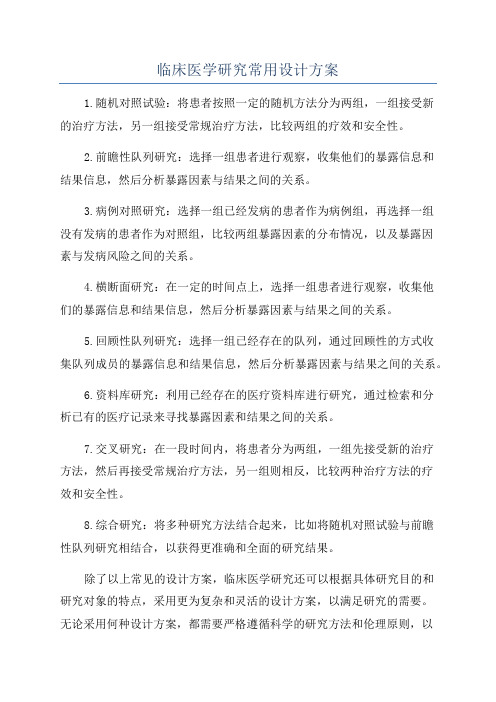
临床医学研究常用设计方案
1.随机对照试验:将患者按照一定的随机方法分为两组,一组接受新
的治疗方法,另一组接受常规治疗方法,比较两组的疗效和安全性。
2.前瞻性队列研究:选择一组患者进行观察,收集他们的暴露信息和
结果信息,然后分析暴露因素与结果之间的关系。
3.病例对照研究:选择一组已经发病的患者作为病例组,再选择一组
没有发病的患者作为对照组,比较两组暴露因素的分布情况,以及暴露因
素与发病风险之间的关系。
4.横断面研究:在一定的时间点上,选择一组患者进行观察,收集他
们的暴露信息和结果信息,然后分析暴露因素与结果之间的关系。
5.回顾性队列研究:选择一组已经存在的队列,通过回顾性的方式收
集队列成员的暴露信息和结果信息,然后分析暴露因素与结果之间的关系。
6.资料库研究:利用已经存在的医疗资料库进行研究,通过检索和分
析已有的医疗记录来寻找暴露因素和结果之间的关系。
7.交叉研究:在一段时间内,将患者分为两组,一组先接受新的治疗
方法,然后再接受常规治疗方法,另一组则相反,比较两种治疗方法的疗
效和安全性。
8.综合研究:将多种研究方法结合起来,比如将随机对照试验与前瞻
性队列研究相结合,以获得更准确和全面的研究结果。
除了以上常见的设计方案,临床医学研究还可以根据具体研究目的和
研究对象的特点,采用更为复杂和灵活的设计方案,以满足研究的需要。
无论采用何种设计方案,都需要严格遵循科学的研究方法和伦理原则,以
确保研究的可靠性和可信度。
临床医学研究设计方案的选择应根据具体研究问题的特点和需要,结合实际情况进行灵活调整。
临床研究常用的两种设计类型

临床研究常用的两种设计类型临床研究常用的两种设计类型1. 随机对照试验设计1.1 研究目的随机对照试验旨在评估新药物或治疗方法的疗效和安全性,通过将患者随机分配到不同的治疗组并进行比较分析,以确定其相对优劣。
1.2 研究步骤1.2.1 确定研究对象首先,确定研究的对象,即需要治疗的疾病或病种。
1.2.2 制定研究方案制定明确的研究方案,包括研究的目的、研究设计、随机分组方法、主要疗效指标、次要疗效指标、安全性评价指标等。
1.2.3 招募研究对象通过医院、社区、互联网等渠道招募符合研究对象标准的患者,并对其进行初步筛选。
1.2.4 随机分组根据预定的随机方法将招募到的患者分配到不同的治疗组和对照组。
1.2.5 实施治疗对治疗组进行新药物或治疗方法的介入,对对照组进行常规治疗或安慰剂处理。
1.2.6 数据收集和分析收集各组的疗效指标、安全性指标等相关数据,并进行统计分析。
1.2.7 结果解读和报告根据统计分析的结果,解读疗效和安全性,并撰写研究报告。
2. 前瞻性队列研究设计2.1 研究目的前瞻性队列研究旨在观察一组人群在一段时间内发生某种疾病或结局的风险,研究人群可具备某些暴露因素。
2.2 研究步骤2.2.1 确定研究对象首先,确定研究的对象和暴露因素,例如研究久坐时间与心血管疾病的关系。
2.2.2 制定研究方案制定明确的研究方案,包括研究的目的、研究设计、参与者的招募标准、数据采集方法等。
2.2.3 招募研究对象通过医院、社区等渠道招募符合研究对象标准的人群,并对其进行初步筛选。
2.2.4 数据采集收集参与者的暴露因素、临床指标、生活方式等相关数据,并进行定期的随访。
2.2.5 结局评估观察参与者在一定时间内发生的疾病或结局,如心血管疾病的发生率、死亡率等。
2.2.6 数据分析对采集到的数据进行统计分析,评估暴露因素与结局之间的关系。
2.2.7 结果解读和报告根据统计分析的结果,解读暴露因素与结局的关系,并撰写研究报告。
临床研究中常用的研究设计有哪些?

临床研究中常用的研究设计有哪些?一、随机对照试验随机对照试验是临床研究中常用的最重要的研究设计之一。
在随机对照试验中,研究组将被随机分为对照组和实验组,对照组接受标准治疗或安慰剂,而实验组接受新的药物或治疗方法。
通过比较两组的疗效差异,可以评估新的药物或治疗方法的疗效。
随机对照试验具有较高的可信度和可靠性,因为通过随机分组,可以减少因个体差异而引起的偏倚。
此外,研究者可以使用盲法,即使参与者不知道自己属于哪个组,以减少主观因素的影响。
二、队列研究设计队列研究设计是临床研究中常用的一种观察性研究设计。
队列研究设计通过对一组人员进行观察,并在一段时间后比较其发生疾病的情况,来评估某一因素与疾病发生之间的关系。
队列研究设计有两种类型:前瞻性队列研究和回顾性队列研究。
前瞻性队列研究通过在开始时记录参与者的特征,并随访一段时间,收集其发生疾病的情况。
回顾性队列研究则是先选择患者,并回顾他们的暴露史和发病情况。
三、交叉研究设计交叉研究设计是临床研究中另一种常用的研究设计。
在交叉研究设计中,每个参与者将接受不同的处理或暴露于不同的条件,然后比较其在不同条件下的反应或效果。
交叉研究设计适用于评估药物的副作用、不同治疗方法的疗效比较等。
它可以减少参与者间的个体差异对结果的影响,并消除了可能存在的混杂因素。
四、病例对照研究病例对照研究是临床研究中常用的一种观察性研究设计。
病例对照研究通过选择一组已患疾病的个体(病例组)和一组未患疾病的个体(对照组),比较两者在暴露于可能的危险因素上是否存在差异,从而评估危险因素与疾病的关联性。
病例对照研究的优势在于可以研究罕见病或疾病发生较慢的关联性,并且可以通过回顾性收集数据,减少研究时间和成本。
五、实验研究设计实验研究设计是临床研究中常用的一种研究设计。
在实验研究设计中,研究者通过对照组和实验组进行比较,评估某个干预措施对结果的影响。
实验研究设计的优势在于可以控制可能干扰结果的混杂因素,并且可以观察到因果关系。
临床研究的类型分类科研设计类别
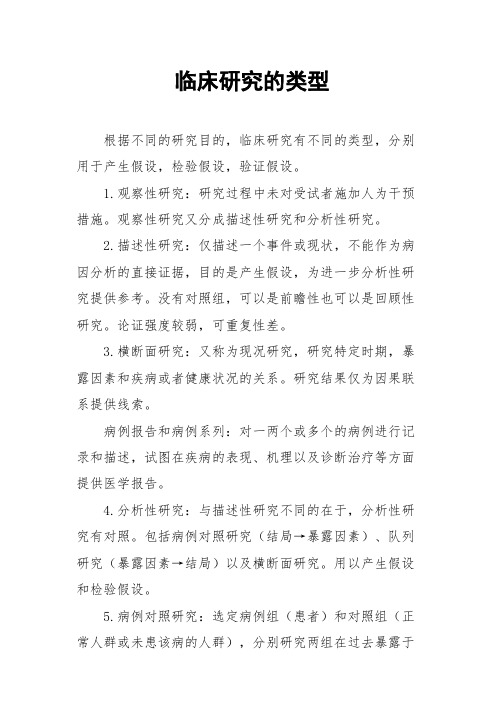
临床研究的类型根据不同的研究目的,临床研究有不同的类型,分别用于产生假设,检验假设,验证假设。
1.观察性研究:研究过程中未对受试者施加人为干预措施。
观察性研究又分成描述性研究和分析性研究。
2.描述性研究:仅描述一个事件或现状,不能作为病因分析的直接证据,目的是产生假设,为进一步分析性研究提供参考。
没有对照组,可以是前瞻性也可以是回顾性研究。
论证强度较弱,可重复性差。
3.横断面研究:又称为现况研究,研究特定时期,暴露因素和疾病或者健康状况的关系。
研究结果仅为因果联系提供线索。
病例报告和病例系列:对一两个或多个的病例进行记录和描述,试图在疾病的表现、机理以及诊断治疗等方面提供医学报告。
4.分析性研究:与描述性研究不同的在于,分析性研究有对照。
包括病例对照研究(结局→暴露因素)、队列研究(暴露因素→结局)以及横断面研究。
用以产生假设和检验假设。
5.病例对照研究:选定病例组(患者)和对照组(正常人群或未患该病的人群),分别研究两组在过去暴露于某个危险因素的情况,进而判断暴露的危险因素与疾病的相关性及强度。
是一种回顾性研究。
用于探索病因,筛选危险因素和检验假设。
6.队列研究:将人群按照暴露于或未暴露于某种因素(包括危险因素、致病因素等)分为两组,之后经过追踪一段时间后比较两组发病或死亡的结局,从而判断暴露的危险因素与疾病的相关性及强度。
是一种前瞻性研究。
用于检验病因假设。
7.实验性研究:研究过程中对受试者施加一定的人为干预措施,从而观察干预因素对于研究对象结局的影响。
也是一种前瞻性研究。
三大要素:对象、干预、结局。
五大原则:对照、重复、随机、均衡、盲法。
根据分组是否随机,分为随机对照研究和非随机对照研究。
8.随机对照研究:采用随机的方法,将合格的研究对象随机分到试验组和对照组,继而分别接受相应的干预措施,观察干预措施的效应,并采取客观的指标衡量试验结果。
最常应用于干预性研究和药物评价。
临床试验常见设计类型有哪些2024
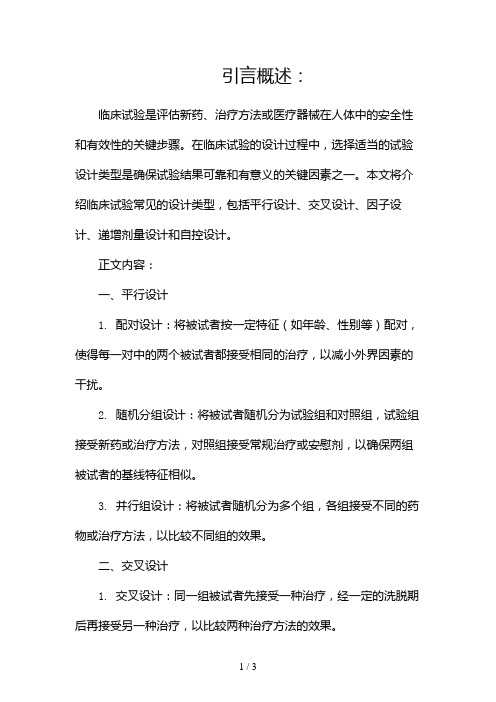
引言概述:临床试验是评估新药、治疗方法或医疗器械在人体中的安全性和有效性的关键步骤。
在临床试验的设计过程中,选择适当的试验设计类型是确保试验结果可靠和有意义的关键因素之一。
本文将介绍临床试验常见的设计类型,包括平行设计、交叉设计、因子设计、递增剂量设计和自控设计。
正文内容:一、平行设计1. 配对设计:将被试者按一定特征(如年龄、性别等)配对,使得每一对中的两个被试者都接受相同的治疗,以减小外界因素的干扰。
2. 随机分组设计:将被试者随机分为试验组和对照组,试验组接受新药或治疗方法,对照组接受常规治疗或安慰剂,以确保两组被试者的基线特征相似。
3. 并行组设计:将被试者随机分为多个组,各组接受不同的药物或治疗方法,以比较不同组的效果。
二、交叉设计1. 交叉设计:同一组被试者先接受一种治疗,经一定的洗脱期后再接受另一种治疗,以比较两种治疗方法的效果。
2. 多周期交叉设计:被试者在一段时间内接受多个周期的治疗,以减小周期之间的不确定性对结果的影响。
3. 平行交叉设计:被试者在同一时间段内同时接受不同治疗,以减小时间因素对结果的干扰。
三、因子设计1. 单因素设计:只考虑一个因素对结果的影响,通过控制其他因素,研究该因素的效果。
2. 双因素设计:考虑两个因素对结果的影响,通过控制其他因素,研究两个因素对结果的交互作用。
3. 多因素设计:考虑多个因素对结果的影响,通过控制其他因素,综合研究多个因素对结果的综合影响。
四、递增剂量设计1. 递增剂量设计:试验药物或治疗方法的剂量从低到高逐渐增加,以寻找最佳剂量和剂量-效应关系。
2. 反向递增剂量设计:试验药物或治疗方法的剂量从高到低逐渐减少,以寻找最佳剂量和剂量-效应关系。
3. 阶梯剂量设计:将被试者分为多个剂量组,每一组接受不同剂量的药物或治疗方法,以确定最佳剂量和剂量-效应关系。
五、自控设计1. 单纯自控设计:同一被试者在不同时间点接受不同治疗,以比较不同治疗方法的效果。
临床试验设计的五种类型

临床试验设计的五种类型简介临床试验是评估医疗干预措施(如药物、治疗方法等)的有效性和安全性的一种科学方法。
临床试验设计是指为了回答特定的研究问题,采取的数据收集方式和数据分析方法的选择和安排。
根据不同的研究目的和研究问题的性质,临床试验设计可以分为以下五种类型。
1. 前瞻性队列研究(Prospective cohort study)前瞻性队列研究是一种长期的观察性研究设计,旨在评估暴露与结果之间的关联性。
研究开始时,研究对象被纳入研究中,并按照暴露和未暴露两组进行分组。
随后,观察并记录暴露组和未暴露组在研究期间的发病率或发生率。
这种设计可以确定暴露与结果之间的因果关系。
优点:•能够确定因果关系•可以研究多种结果缺点:•需要很长时间进行观察•受到随访率和观察偏倚的影响2. 随机对照试验(Randomized Controlled Trial, RCT)随机对照试验是一种被认为是证据层次最高、最可靠的研究设计,用于评估新药物和治疗方法的疗效。
参与者被随机分配到接受新干预措施的实验组或接受常规治疗(对照组)的控制组。
研究人员在整个试验过程中通过对两组进行比较来评估新干预措施的疗效和安全性。
优点:•可以确定因果关系•具有较高的内部效度缺点:•代表性有限•受到实践偏差的影响3. 随机截断试验(Randomized Controlled Trial with Truncation)随机截断试验是一种特殊类型的随机对照试验,旨在评估预防措施的效果。
这种设计要求参与者在研究开始时根据某个因素进行分组,然后在特定事件发生后被截断。
通过比较两组参与者在特定事件发生之前和之后的结果,评估预防措施的效果。
优点:•易于进行•结果可靠缺点:•不能确定因果关系•结果可能受到其他因素的影响4. 回顾性队列研究(Retrospective cohort study)回顾性队列研究是一种观察性研究设计,用于评估暴露与结果之间的关联性。
临床研究常用的两种设计类型

临床研究常用的两种设计类型在医学领域中,临床研究对于推动医学进步、改善医疗质量和保障患者健康具有至关重要的意义。
而在众多的临床研究方法中,有两种设计类型被广泛应用,它们分别是随机对照试验(Randomized Controlled Trial,RCT)和队列研究(Cohort Study)。
接下来,让我们详细了解一下这两种设计类型。
一、随机对照试验(RCT)随机对照试验被视为临床研究中的“金标准”,其主要特点是通过随机分组的方式,将研究对象分配到不同的干预组和对照组,然后对两组进行比较,以评估干预措施的效果。
(一)设计原理在随机对照试验中,随机分组是确保研究结果科学性和可靠性的关键步骤。
通过随机化,可以使两组研究对象在已知和未知的混杂因素方面达到均衡,从而减少偏倚。
同时,为了排除其他因素的干扰,通常还会采用盲法,即研究者、研究对象或者两者都不知道研究对象所属的分组情况。
(二)实施步骤1、确定研究问题和研究目的:明确需要评估的干预措施以及预期的治疗效果。
2、选择研究对象:制定严格的纳入和排除标准,以确保研究对象的同质性。
3、随机分组:使用随机数字表、随机数生成器等方法将研究对象随机分配到干预组和对照组。
4、干预措施的实施:干预组接受特定的治疗或干预,对照组则接受常规治疗或安慰剂。
5、随访和观察:在一定的时间内对研究对象进行随访,观察和记录相关的结局指标。
6、数据分析:比较两组的结局指标,评估干预措施的有效性和安全性。
(三)优点1、能够有效地控制混杂因素,得出较为准确的因果关系结论。
2、结果具有较高的内部有效性和科学性,可为临床实践提供可靠的依据。
(四)局限性1、研究环境相对理想化,可能与真实的临床环境存在差异。
2、实施过程较为复杂,需要严格的质量控制和管理。
3、对于某些罕见病或特殊人群,可能难以招募到足够的研究对象。
二、队列研究队列研究是一种观察性研究方法,它通过观察不同暴露因素下人群的发病或死亡情况,来探讨暴露因素与疾病之间的关联。
临床研究常见的设计类型

观察性研究由于是在自然环境下进行观察,因此可能会受到各种因素的影响, 如环境、时间、个体差异等,导致数据质量不稳定。此外,由于无法控制外部 变量,观察性研究难以确定因果关系。
03
队列研究
定义与特点
定义
队列研究是一种流行病学研究方法, 将人群按照是否暴露于某可疑因素分 组,追踪各组的结局并比较其差异。
特点
队列研究能够提供暴露与结局之间的 因果关系证据,通过比较不同组之间 的差异,可以评估暴露因素对健康的 影响。
ቤተ መጻሕፍቲ ባይዱ
适用范围
适用于研究人群中某种疾病的发病率 和影响因素,特别是对于罕见病或慢 性病的研究。
可以用于评估不同干预措施的效果, 例如药物治疗、生活方式改变等。
优缺点分析
优点
能够提供因果关系的证据,适用于长期研究,可以评估多种暴露因素对健康的影响。
特点
病例对照研究适用于探索病因和危险因素,通过回顾性分析,可以在短时间内收集大量 数据,且样本量相对较小。
适用范围
病因研究
病例对照研究适用于确定病因和危险因素,通过比较病例 与对照在暴露因素上的差异,分析病因和危险因素的关联 强度。
筛检试验评价
病例对照研究可用于评价筛检试验的效果,通过比较病例 与对照在筛检试验结果上的差异,评估筛检试验的敏感性 和特异性。
05
横断面研究
定义与特点
横断面研究是一种观察性研究方法,其特点是 在某一特定时间点收集研究对象的资料,以评 估不同特征或状况与结局的关系。
它通常采用普查或抽样调查的方式,收集的数 据包括人口基本信息、疾病状况、生活习惯等 。
横断面研究能够快速地了解某一特定群体的疾 病分布和流行情况,为制定预防和干预措施提 供依据。
临床研究的各个类型你分得清么

临床研究的各个类型你分得清么临床研究是医学领域中一项重要的研究方法,旨在评估不同治疗方法对疾病治疗效果的影响。
根据研究设计和目的的不同,临床研究可以分为多种类型。
在本文中,我们将逐一介绍各个类型的临床研究,以帮助读者更好地理解和区分它们。
一、随机对照试验(RCT)随机对照试验是一种最常见和最可靠的临床研究设计,用于评估治疗方法的疗效。
RCT通过将研究对象随机分配到接受不同治疗方式(例如药物、手术或其他干预措施)的组别,并进行对比观察,来判断不同治疗方法的差异。
这种设计能够控制多种干扰因素对研究结果的影响,具有较高的证据水平。
二、队列研究队列研究是一种前瞻性的观察性研究设计,通过对一组研究对象进行长期跟踪观察,以评估暴露因素(例如吸烟、饮食等)与疾病发生之间的关系。
根据研究对象的选择方式,队列研究可以分为前瞻性队列研究和回顾性队列研究。
这种设计能够为研究人员提供相对较高的证据水平,但也存在一定的时效性问题。
三、病例对照研究病例对照研究是一种回顾性观察性研究设计,通过比较存在某种疾病的个体(病例组)与无该疾病的个体(对照组)之间的暴露差异,来评估暴露因素与疾病之间的关系。
这种设计常用于研究罕见病或病发病速度慢的疾病,但对回顾性数据的依赖性较高,容易受到记忆偏倚等因素的影响。
四、交叉研究交叉研究是一种观察性研究设计,通过在不同时间点上对同一组研究对象进行两个或多个治疗方法的比较,来评估这些治疗方法的效果。
与随机对照试验相比,交叉研究更适合评估某一特定个体对不同治疗方法的反应,但容易受到时间效应和观测顺序的影响。
五、系统评价与Meta分析系统评价与Meta分析是一种综合性研究方法,通过收集、整理和分析已有的临床研究数据,以全面评估某一特定疾病或治疗方法的效果和安全性。
这种方法能够提供较高的证据水平,并尽可能减少单个研究结果的偏差。
然而,受限于所包含研究的质量和可比性,系统评价与Meta分析的结果可能存在一定的不确定性。
临床研究实验设计类型
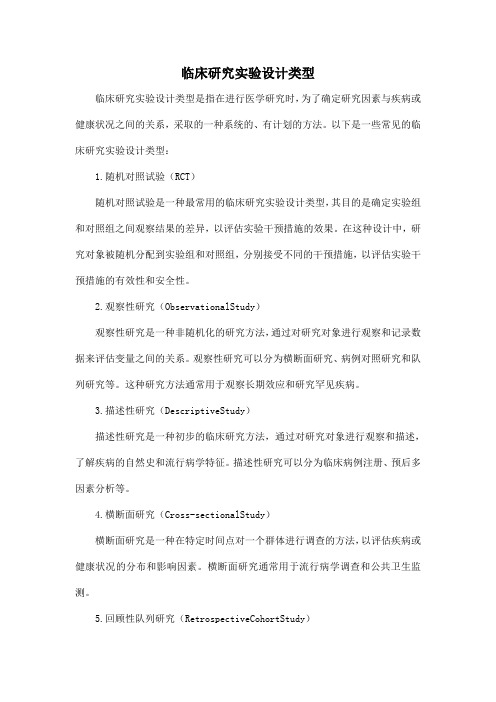
临床研究实验设计类型临床研究实验设计类型是指在进行医学研究时,为了确定研究因素与疾病或健康状况之间的关系,采取的一种系统的、有计划的方法。
以下是一些常见的临床研究实验设计类型:1.随机对照试验(RCT)随机对照试验是一种最常用的临床研究实验设计类型,其目的是确定实验组和对照组之间观察结果的差异,以评估实验干预措施的效果。
在这种设计中,研究对象被随机分配到实验组和对照组,分别接受不同的干预措施,以评估实验干预措施的有效性和安全性。
2.观察性研究(ObservationalStudy)观察性研究是一种非随机化的研究方法,通过对研究对象进行观察和记录数据来评估变量之间的关系。
观察性研究可以分为横断面研究、病例对照研究和队列研究等。
这种研究方法通常用于观察长期效应和研究罕见疾病。
3.描述性研究(DescriptiveStudy)描述性研究是一种初步的临床研究方法,通过对研究对象进行观察和描述,了解疾病的自然史和流行病学特征。
描述性研究可以分为临床病例注册、预后多因素分析等。
4.横断面研究(Cross-sectionalStudy)横断面研究是一种在特定时间点对一个群体进行调查的方法,以评估疾病或健康状况的分布和影响因素。
横断面研究通常用于流行病学调查和公共卫生监测。
5.回顾性队列研究(RetrospectiveCohortStudy)回顾性队列研究是一种回顾性的研究方法,通过收集已经存在的数据来确定一个特定因素与结果之间的关系。
这种方法通常用于评估疾病的预防和治疗方法的效果。
6.巢式病例对照研究(NestedCase-ControlStudy)巢式病例对照研究是一种病例对照研究的设计方法,通过在已经存在的队列或注册研究中选取病例和对照,以评估特定因素与疾病之间的关系。
这种方法通常用于评估生活和环境因素对疾病的影响。
7.临床病例注册(ClinicalCaseRegistry)临床病例注册是一种收集临床数据的工具,用于监测和评估疾病的疗效和安全性。
临床试验常见的设计类型

临床试验常见的设计类型临床试验是评价新药疗效和安全性的重要手段,根据试验设计的不同类型,可以更好地获得科学可靠的试验结果。
下面将介绍临床试验常见的设计类型。
一、随机对照试验(RCT)随机对照试验是目前临床试验中最为常见的设计类型之一。
该设计类型通过将参与试验的患者随机分为两组,一组接受新药治疗,另一组接受安慰剂或标准治疗,以比较两组患者的疗效和安全性。
随机对照试验可以减少治疗结果的偏倚,提高试验结果的可靠性。
同时,试验结果还可以用于指导临床实践和药物注册。
二、交叉试验交叉试验是一种将同一组患者分为两个或多个时期,依次接受不同治疗的试验设计。
患者在试验的不同阶段分别接受不同治疗,以比较不同治疗对患者的疗效和安全性的影响。
交叉试验可以减少患者间的差异,提高试验结果的可靠性。
然而,交叉试验需要较长的时间和较高的患者配合度,适用于治疗效果较为稳定的疾病。
三、前瞻性队列研究前瞻性队列研究是通过对一组人群进行长期的观察和随访,收集并分析相关数据,从而研究某种因素与疾病发生、发展的关系。
该设计类型可以评估暴露因素对疾病的影响,并研究因果关系。
前瞻性队列研究可以提供较高水平的证据,对于研究疾病的发病机制和预防措施具有重要意义。
四、回顾性研究回顾性研究是通过收集和分析已有的资料,回顾性地研究某种因素与疾病的关系。
该设计类型适用于研究罕见疾病或长期随访困难的情况。
回顾性研究可以提供初步的研究结果,为进一步开展前瞻性研究提供依据。
五、队列研究队列研究是指在一定时期内,对人群进行观察和随访,收集相关数据,从而研究某种因素与疾病发生、发展的关系。
队列研究分为前瞻性队列研究和回顾性队列研究两种类型。
队列研究可以评估暴露因素对疾病的影响,并研究因果关系。
该设计类型可以提供较高水平的证据,对于研究疾病的发病机制和预防措施具有重要意义。
六、单盲试验和双盲试验单盲试验是指患者或评估者其中之一不知道患者接受的是实验治疗还是对照治疗;双盲试验是指患者和评估者均不知道患者接受的是实验治疗还是对照治疗。
临床研究设计类型

临床研究设计类型临床研究是为了评估医疗干预措施是否安全有效以及对人体生理和病理过程的影响而进行的研究。
临床研究设计是研究者根据研究目的和研究对象的特点,选择合适的研究方案和方法进行实施的过程。
根据研究目标和特点的不同,临床研究设计可以分为观察性研究设计和实验性研究设计。
观察性研究设计是根据已有的人群或患者的特点和行为习惯,观察并记录相关的信息和指标。
观察性研究设计可以是横断面研究、纵向研究和病例对照研究。
1.横断面研究:横断面研究是在特定的时间点上对人群或患者进行观察和调查。
研究者通过问卷调查或检测指标等方法,收集研究对象的相关信息,了解不同因素与疾病的关系。
横断面研究的优点是简单、快速、低成本,但不能确定因果关系。
2.纵向研究:纵向研究是在一段时间内对同一群人群或患者进行多次观察和调查。
研究者可以观察人群或患者在时间上的变化,并分析可能的因果关系。
纵向研究的优点是可以观察和评估变量的变化,而不仅仅是横断面研究的静态快照。
3.病例对照研究:病例对照研究是研究特定疾病或事件的发病原因和危险因素的一种设计。
研究者选择已经有疾病的病例以及没有疾病的对照组,对两组进行比较分析,寻找可能的危险因素和保护因素。
病例对照研究的优点是可以研究罕见疾病或事件,且成本相对较低。
实验性研究设计是为了评估特定治疗干预措施的效果和安全性而进行的研究。
实验性研究设计可以是随机对照试验、交叉试验和开放试验。
1.随机对照试验:随机对照试验是在临床实践中最常用的研究设计。
研究者将参与者随机分配到接受不同干预措施的组别,比较两组间的结果差异。
随机对照试验的优点是能够控制潜在的干扰因素,确保研究结果的可靠性。
2.交叉试验:交叉试验是参与者先接受一种治疗,然后经过一段时间后再接受另一种治疗,比较两种治疗的效果。
交叉试验的优点是每个参与者可以充当自己的对照组,减少个体差异的影响。
3.开放试验:开放试验是指参与者和研究者都知道所接受的治疗干预,而不是进行“盲法”。
临床研究设计类型

临床研究设计类型众所周知,临床研究是一项重要的科研工作,它对于药物的安全性和有效性评估、治疗方案的制定等方面有着至关重要的作用。
而在进行临床研究时,合理选择研究设计类型是非常重要的,因为它将直接影响到研究结果的可靠性和可推广性。
本文将探讨几种常见的临床研究设计类型,并简要介绍它们的特点和适用场景。
一、随机对照试验随机对照试验是最常见的临床研究设计类型之一,它通过将研究对象随机分为实验组和对照组进行比较,评估治疗效果。
这种设计类型可以有效地控制干扰因素,提高研究结果的可信度。
随机对照试验可以分为单盲、双盲和三盲试验,其中单盲试验只有研究者不知道研究对象的分组情况,双盲试验除了研究者外,研究对象也不清楚自己属于实验组还是对照组,而三盲试验则连评估结果的分析者也不知道研究对象的分组情况。
这些设计类型的选择取决于研究的具体需求。
二、队列研究设计队列研究设计是一种观察性研究设计,特点是在开始时选择一组人进行观察,然后按照暴露因素的存在与否或程度的不同,将他们划分为不同的组别进行随访,最后比较暴露组和非暴露组之间的结果差异。
队列研究设计可以是前瞻性的,也可以是回顾性的。
前瞻性队列研究是在研究开始时就进行观察和随访,而回顾性队列研究则是在研究结束时回顾研究对象的过往信息。
队列研究设计适用于探索暴露因素与结局之间的潜在关系,但不能证明因果关系。
三、病例对照研究设计病例对照研究设计是一种观察性研究设计,它通过比较患有某种疾病的病例和没有患有该疾病的对照人群,来评估潜在的暴露因素与疾病之间的关系。
病例对照研究设计常用于研究罕见疾病或疾病发生较慢的情况。
研究者可以回顾性地收集病例和对照的相关信息,来分析暴露因素与疾病风险之间的关系。
然而,病例对照研究设计的一个缺点是可能存在回忆偏倚,即患病者可能更容易回忆起暴露因素,导致结果的不准确性。
四、交叉研究设计交叉研究设计是一种常用于比较不同治疗方案或干预措施效果的设计类型。
- 1、下载文档前请自行甄别文档内容的完整性,平台不提供额外的编辑、内容补充、找答案等附加服务。
- 2、"仅部分预览"的文档,不可在线预览部分如存在完整性等问题,可反馈申请退款(可完整预览的文档不适用该条件!)。
- 3、如文档侵犯您的权益,请联系客服反馈,我们会尽快为您处理(人工客服工作时间:9:00-18:30)。
Cross-Sectional Study
Begin with:
Defined Population
Then:
Gather Data on Exposure and Disease
Exposed, with Disease
Exposed, No Disease
Not Exposed, with Disease
Cancer
Ruddy KJ, et al: J Clin Oncol. 2014 Apr 10;32(11):1151-6
Cross-Sectional Studies
Strengths:
Useful for public health surveys Useful for public policy (allocation of resources) Good initial step in evaluating associations Cost-effective use of resources
Not Exposed, No Disease
Prevalence and Control of Diabetes in Chinese Adults
Ning Guang et al: JAMA. 2013 Sep 4;310(9):948-59
Prospective Study of Fertility Concerns and Preservation Strategies in Young Women With Breast
3
Randomized-Clinical Trial Cohort Studies Case Control Studies Cross Sectional Studies Case Report
4
Case Report/Case series
5
Case Report/Case series
Sample: single patient or multiple patients Design: Descriptive-no comparison is given with
Types of Clinical Study Design and clinical application
Lin-Quan Tang Department of Nasopharyngeal carcinoma, Sun Yat-sen University Cancer Center, Guangzhou, P. R. China
6
Case-Exsample: Squamous-Cell Carcinoma of the Penis with Human Papillomavirus
7
The New England Journal of medicine
Case-Exsample: Long-Term Disease Control in a Patient With Recurrent Bone-Only Oligometastatic Nasopharyngeal Carcinoma
Case Report/Case
Series
Cross-
Case-
Sectional Control
Cohortຫໍສະໝຸດ Randomized Clinical Trials (RCT)
2
Hierarchy of Evidence
Higher Quality Evidence
Lower Quality Evidence
9
Cross-Sectional Studies
10
Cross-Sectional Studies
Sample: includes a sample of everyone in a population, regardless of exposure or outcome status
Design: In each individual, simultaneously determine the exposure and disease status
“Snap shot”; No follow-up data Examples:
Prevalence surveys (How common is kidney disease in a population?)
Etiology (Is hypertension associated with prevalent kidney disease?)
Learning Objectives
1
Learn the types of study designs used in clinical research
2
Provide an overview of observational and intervention study design
3
Understand the strengths and weakness of study designs
Types of Study designs
Study Designs
Observational Studies: Observe exposures and
outcomes
Clinical (Experimental) Trials: Assign exposure and observe outcomes
an untreated group Unique finding or association reported Example:
- Anecdotal patients: A patient who take vitamins is “cure” of cancer
- Medication side effect
8
J Clin Oncol. 2014 Jun 9
Case Report/Case series
Strengths:
Good initial step in evaluating associations
Limitations:
No control group Causation can not be determined
